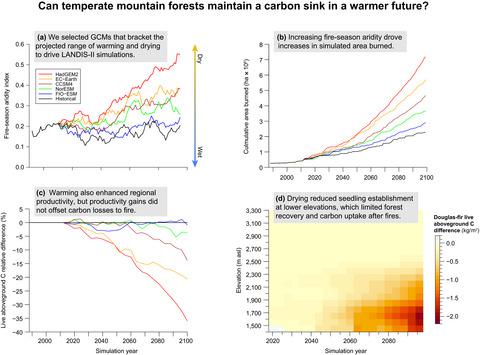Our official English website, www.x-mol.net, welcomes your feedback! (Note: you will need to create a separate account there.)
Increased burning in a warming climate reduces carbon uptake in the Greater Yellowstone Ecosystem despite productivity gains
Journal of Ecology ( IF 5.5 ) Pub Date : 2020-11-20 , DOI: 10.1111/1365-2745.13559 Paul D. Henne 1 , Todd J. Hawbaker 1 , Robert M. Scheller 2 , Feng Zhao 3 , Hong S. He 4 , Wenru Xu 4 , Zhiliang Zhu 5
中文翻译:

尽管生产力得到提高,但在变暖的气候中增加的燃烧减少了大黄石生态系统中的碳吸收
更新日期:2020-11-20
Journal of Ecology ( IF 5.5 ) Pub Date : 2020-11-20 , DOI: 10.1111/1365-2745.13559 Paul D. Henne 1 , Todd J. Hawbaker 1 , Robert M. Scheller 2 , Feng Zhao 3 , Hong S. He 4 , Wenru Xu 4 , Zhiliang Zhu 5
Affiliation

|
- The effects of changing climate and disturbance on mountain forest carbon (C) stocks vary with tree species distributions and over elevational gradients. Warming can not only increase C uptake by stimulating productivity at high elevations but also enhance C release by increasing respiration and the frequency, intensity and size of wildfires.
- To understand the consequences of climate change for temperate mountain forests, we simulated interactions among climate, wildfire, tree species and their combined effects on regional C stocks in forests of the Greater Yellowstone Ecosystem, USA (GYE) with the LANDIS‐II landscape change model. Simulations used historical climate and future potential climate represented by downscaled projections from five general circulation models (GCMs) that bracket the range of variability under the representative concentration pathway (RCP) 8.5 emissions scenario.
- Total ecosystem C increased by 67% through 2100 in simulations with historical climate, and by 38%–69% with GCM climate. Differences in C uptake among GCMs resulted primarily from variation in area burned, not productivity. Warming increased productivity by extending the growing season, especially near upper tree line, but did not offset biomass losses to fire. By 2100, simulated area burned increased by 27%–215% under GCM climate, with the largest increases after 2050. With warming >3°C in mean annual temperature, the increased frequency of large fires reduced live C stocks by 4%–36% relative to the control, historical climate scenario. However, relative losses in total C were delayed under GCMs with large increases in summer precipitation and buffered by C retained in soils and the wood of fire‐killed trees. Increasing fire size limited seed dispersal, and reductions in soil moisture limited seedling establishment; both effects will likely constrain long‐term forest regeneration and C uptake.
- Synthesis. Forests in the GYE can maintain a C sink through the mid‐century in a warming climate but continued warming may cause the loss of forest area, live above‐ground biomass and, ultimately, ecosystem C. Future changes in C stocks in similar forests throughout western North America will depend on regional thresholds for extensive wildfire and forest regeneration and therefore, changes may occur earlier in drier regions.
中文翻译:

尽管生产力得到提高,但在变暖的气候中增加的燃烧减少了大黄石生态系统中的碳吸收
- 气候变化和干扰对山区森林碳(C)库的影响随树种分布和海拔梯度而变化。变暖不仅可以通过刺激高海拔地区的生产力来增加C的吸收,还可以通过增加呼吸作用以及野火的频率,强度和大小来提高C的释放。
- 为了了解气候变化对温带山区森林的影响,我们使用LANDIS-II景观变化模型模拟了气候,野火,树木物种之间的相互作用以及它们对美国大黄石生态系统(GYE)森林中区域碳库的综合影响。 。模拟使用了历史气候和未来潜在气候,这些气候由五个通用循环模型(GCM)的按比例缩小的预测表示,该模型将代表性的浓度路径(RCP)8.5排放情景下的变化范围括起来。
- 到2100年,在具有历史气候的模拟中,生态系统总碳增加了67%,而在GCM气候中,生态系统的总碳增加了38%–69%。GCM之间吸收C的差异主要是由于燃烧面积的变化而不是生产率的变化。气候变暖通过延长生长期,尤其是在较高的林木线附近,提高了生产力,但并没有抵消生物量因火灾而损失的情况。到2100年,在GCM气候下,模拟燃烧面积增加了27%–215%,在2050年之后增幅最大。随着年平均气温升高> 3°C,大火的发生频率降低了活碳储存量4%–36相对于对照的历史气候情景的百分比。但是,在GCMs下,总C的相对损失被延迟了,夏季降水量大大增加,并被土壤和火烧树木中残留的C所缓冲。火势的增加限制了种子的传播,土壤水分的减少限制了幼苗的生长;两种影响都可能会限制长期森林的再生和碳的吸收。
- 综合。GYE的森林可以在整个世纪中叶在变暖的气候中维持一个C汇,但持续变暖可能会导致森林面积的损失,生活在地上的生物量以及最终的生态系统C的损失。整个类似森林中C储量的未来变化北美西部地区将取决于广泛的野火和森林更新的区域阈值,因此,较干旱地区的变化可能会更早发生。


























 京公网安备 11010802027423号
京公网安备 11010802027423号